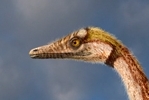Innovative research has made a long-extinct katydid—which inhabited the world of dinosaurs like stegosaurus, allosaurus, and diplodocus—sing again. The discovery of an incredibly well-preserved fossil of a new species of katydid, dubbed Archaboilus musicus, gave biomechanical experts the opportunity to recreate a song not heard in 165 million years, according to new research published in the Proceedings of the National Academy of Sciences (PNAS).
Examining the insect’s seven centimeter long fossil wings under microscope, researchers were able to see how the prehistoric male katydid employed stridulation, i.e. rubbing body parts together, to produce a song to attract a female. Given the insect’s morphology, biomechanical experts were then able to decipher that the insect sang at a low pitch of 6.4 kHz with each note lasting about 16 milliseconds, producing a single, decisive note. [to listen to sound click here]
“This discovery indicates that pure tone communication was already exploited by animals in the middle Jurassic, some 165 million years ago. For Archaboilus, as for living [katydid] species, singing constitutes a key component of mate attraction,” explains Daniel Robert, biomechanical expert at Bristol’s School of Biological Sciences, in a press release. “Singing loud and clear advertises the presence, location and quality of the singer, a message that females choose to respond to—or not.”
This is the first insect fossil to betray the secrets of its mating calls, and researchers say its likely the most ancient music ever heard. The katydid’s song was adapted to travel long-distance in a sparse environment of conifers and giant ferns. However, by singing the katydid would have also attracted unwanted attention: hungry predators.
“Today, all species of katydids that use musical calls are nocturnal so musical calls in the Jurassic were also most likely an adaptation to nocturnal life. Being nocturnal, Archaboilus musicus probably escaped from diurnal predators like Archaeopterix, but it cannot be ruled out that Jurassic insectivorous mammals like Morganucodon and Dryolestes also listened to the calls of Archaboilus and preyed on them,” explains Fernando Montealegre-Zapata, also a biomechanical expert.
How species adapt is often informed by such difficult choices: Archaboilus musicus‘s loud musical tone allowed mates to hear it far-and-wide perhaps giving it an edge in breeding, however the trade-off may have meant higher chance of being eaten.
The katydid family that Archaboilus musicus belongs to first arose in the late Triassic before vanishing entirely prior to the early Cretaceous, however its propensity for song would survive to modern katydids.
CITATION. Gu, J. J., Montealegre-Z, F., Robert, D., Engel, M. S., Qiao, G. X. and Ren, D. Wing stridulation in a jurassic katydid (insecta, orthoptera) produced low-pitched musical calls to attract females. Proc. Natl. Acad. Sci. USA DOI:10.1073/pnas.111837210
Related articles
Scientists discover giant species of crocodile; luckily it is extinct
(09/15/2011) Researchers excavating a coal mine in Colombia have discovered a previously unknown species of prehistoric crocodile. The beast is described in the September 15 issue of the journal Palaeontology.
King of dinosaurs was a hunter, not a scavenger
(01/26/2011) Ecologists say they have used a computer model to put to rest a nearly century-old debate. Did Tyrannosaurus Rex, one of the world’s most well-known dinosaurs, hunt down its prey like a lion on the plains, or, instead, did it scavenge meals from other hunters like a vulture? According to scientists with the Zoological Society of London (ZSL) the Tyrannosaurus had only one choice in order to survive: hunt.
Picture: scientists identify first known single-fingered dinosaur

(01/25/2011) Paleontologists working in China have discovered a first for dinosaurs: a species with only one finger. Named Linhenykus monodactylus, the extinct species stood only about two feet high and weighed about as much as a large parrot. Although small, the new dinosaur was a member of the carnivorous therapod dinosaurs, which include the infamous Tyrannosaurus Rex. The find was announced in the Proceedings of the National Academy of Sciences.